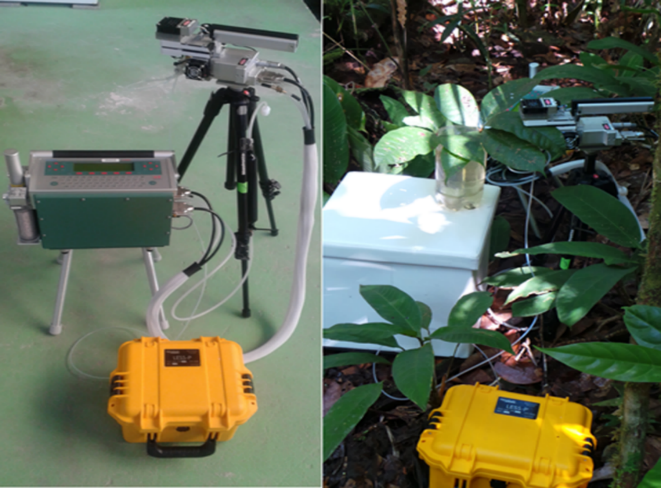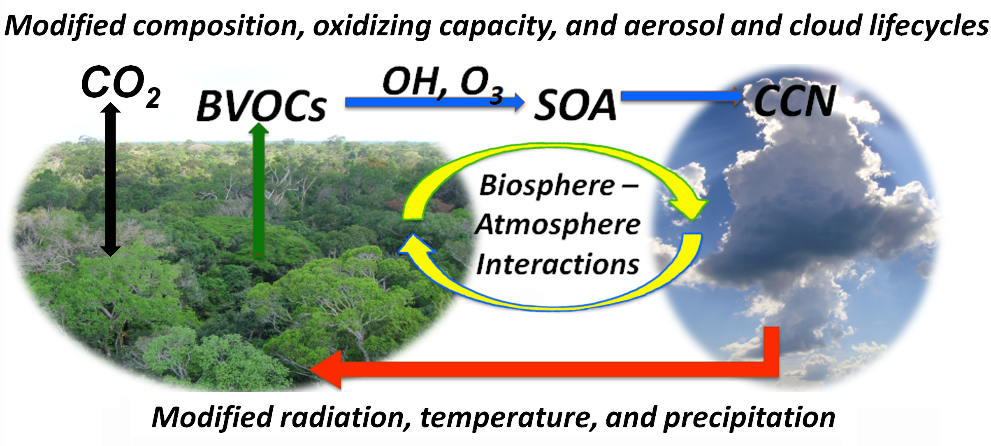The Science
1. Tropical forests are acknowledged to be the largest global source of isoprene (C5H8) and monoterpenes (C10H16) emissions, with current synthesis studies suggesting few tropical species emit isoprenoids (20-38%) and do so with highly variable emission capacities, including within the same genera.
2. This apparent lack of a clear phylogenetic thread has created difficulties both in linking isoprenoid function with evolution and for the development of accurate biosphere-atmosphere models.
3. Here, a field-portable system was developed for the identification and quantification of isoprene and monoterpene emissions from leaves in parallel with leaf physiological measurements including photosynthesis and transpiration.
4. The system will enable the characterization of carbon and energy allocation to the biosynthesis and emission of isoprenoids linked with photosynthesis and their biological and environmental sensitivities (e.g. light, temperature, CO2).
5. Using this system, a systematic isoprenoid emission study was conducted across the five most abundant tree genera in the Amazon.
The Impact
1. The hyperdominant species (69) across the top five most abundant genera, which make up about 50% of all individuals in the Basin, showed high abundance of isoprenoid emitters (isoprene: 63.8%; monoterpenes: 17.4%; both 11.6%). Among the abundant genera, only Pouteria had a low frequency of isoprene emitting species (15.8% of 19 species). In contrast, Protium, Licania, Inga, and Eschweilera were rich in isoprene emitting species (83.3% of 12 species, 61.1% of 18 species, 100% of 8 species, and 100% of 12 species, respectively).
2. In every genus, species with light-dependent isoprene emissions together with β-ocimene emissions were observed.
3. These observations demonstrate that isoprene biological function and phylogenetic relationship studies cannot be conducted without including monoterpenes. The findings support the emerging view of the evolution of isoprene synthases from ocimene synthases.
4. The finding (i.e. 64% of species observed vs 20% suggested in the literature) improves understanding of isoprenoid function-evolution relationships and represents a base for the development of more accurate Earth System Models.
Summary
Tropical forests are acknowledged to be the largest global source of isoprene (C5H8) and monoterpenes (C10H16) emissions, with current synthesis studies suggesting few tropical species emit isoprenoids (20-38%) and do so with highly variable emission capacities, including within the same genera. This apparent lack of a clear phylogenetic thread has created difficulties both in linking isoprenoid function with evolution and for the development of accurate biosphere-atmosphere models. Here, we present a systematic emission study of “hyperdominant” tree species in the Amazon Basin. Across 162 individuals, distributed among 25 botanical families and 113 species, isoprenoid emissions were widespread among both early and late successional species (isoprene: 61.9% of the species; monoterpenes: 15.0%; both isoprene and monoterpenes: 9.7%). The hyperdominant species (69) across the top five most abundant genera, which make up about 50% of all individuals in the Basin, had a similar abundance of isoprenoid emitters (isoprene: 63.8%; monoterpenes: 17.4%; both 11.6%). Among the abundant genera, only Pouteria had a low frequency of isoprene emitting species (15.8% of 19 species). In contrast, Protium, Licania, Inga, and Eschweilera were rich in isoprene emitting species (83.3% of 12 species, 61.1% of 18 species, 100% of 8 species, and 100% of 12 species, respectively). Light response curves of individuals in each of the five genera showed light-dependent, photosynthesis-linked emission rates of isoprene and monoterpenes. Importantly, in every genus, we observed species with light-dependent isoprene emissions together with monoterpenes including β-ocimene. These observations support the emerging view of the evolution of isoprene synthases from β-ocimene synthases. Our results have important implications for understanding isoprenoid function-evolution relationships and the development of more accurate Earth System Models.



Figure 1. Images of the coupled leaf portable photosynthesis (Li6400XT) and volatile emission autosampler (Less-P) system developed in this study for the combined analysis of net photosynthesis and volatile isoprenoid emissions at remote field site locations in the Amazon forest.
Figure 2. Graphical illustration of the biochemical, ecological, and atmospheric roles of volatile isoprenoids (isoprene and monoterpenes) within plants, ecosystems, and the atmosphere. Volatile isoprenoids protect photosynthesis during abiotic stress, are involved in multi-trophic interactions within ecosystems, and following atmospheric oxidation, impact climate through influences over secondary organic aerosol (SOA) and cloud condensation nuclei (CCN) lifecycles in the troposphere.
Figure 3. Schematic showing biosphere-atmosphere interactions and climate feedbacks mediated by exchange of CO2 and biogenic volatile organic compounds (BVOCs).
PI Contact: Kolby Jardine, Earth and Environmental Sciences Area, Lawrence Berkeley National Laboratory, One Cyclotron Road, 84-155, Berkeley, CA, USA 94720, kjjardine@lbl.gov
Contact (BER PM): Daniel Stover, SC-23.1, Daniel.Stover@science.doe.gov (301-903-0289)
Funding
This material is based upon work supported as part of the Next Generation Ecosystem Experiments-Tropics (NGEE-Tropics) funded by the U.S. Department of Energy, Office of Science, Office of Biological and Environmental Research through contract No. DE-AC02-05CH11231 to LBNL, as part of DOE’s Terrestrial Ecosystem Science Program. Funding for the data analysis and manuscript preparation was provided by the DOE Office of Science Early Career Research Program (FY18 DOE National Laboratory Announcement Number: LAB 17-1761), Topic: Plant Systems for the Production of Biofuels and Bioproducts. Graduate student support was supported by the National Council for Scientific and Technological Development (CNPq) in Brazil. Logistical and scientific support is acknowledged by the Forest Management (MF), Climate and Environment (CLIAMB), and Large-Scale Biosphere-Atmosphere (LBA) programs at the National Institute for Amazon Research (INPA).
Publications
1. Jardine K, Zorzanelli R, Gimenez B, Piva L, Teixeira A, Fontes C, Robles E, Chambers J, Higuchi N, Martin S (2020) Leaf isoprene and monoterpene emission distribution in the 5 most abundant tree genera in the Amazon Basin, Phytochemistry, Vol. 175, 112366. https://doi.org/10.1016/j.phytochem.2020.112366
2. Jardine K, Zorzanelli R, Gimenez B, Robles E, Piva L (2020) Development of a portable leaf photosynthesis and volatile organic compounds emission system, MethodsX, Vol. 7, 100880 https://doi.org/10.1016/j.mex.2020.100880
3. Jardine, K., Zorzanelli R., Gimenez B., Robles E., Piva L.(2020) Leaf gas exchange and volatile isoprenoid emission dataset of hyperdominant tree genera in the Amazon forest, Phytochemistry Data in Brief.
Related Links
Data DOIs:
1. Jardine K; Zorzanelli R; Gimenez B; Robles E; Rosa L (2020): Leaf isoprene and monoterpene emission data-set across hyperdominant tree genera in the Amazon basin. 1.0. NGEE Tropics Data Collection. (dataset). http://dx.doi.org/10.15486/ngt/1602142
2. Jardine K, Zorzanelli R, Gimenez B, Robles E, Rosa L (2020): Raw leaf gas exchange data in the Amazon basin, 2014-2016. 1.0. NGEE Tropics Data Collection. (dataset). http://dx.doi.org/10.15486/ngt/1602143
3. Jardine K, Zorzanelli R, Gimenez B, Robles E, Rosa L (2020): Raw leaf isoprene and monoterpene emission GC-MS chromatograms/calibrations for MassHunter software, Brazil, 2014-2016. 1.0. NGEE Tropics Data Collection. (dataset). http://dx.doi.org/10.15486/ngt/1602144